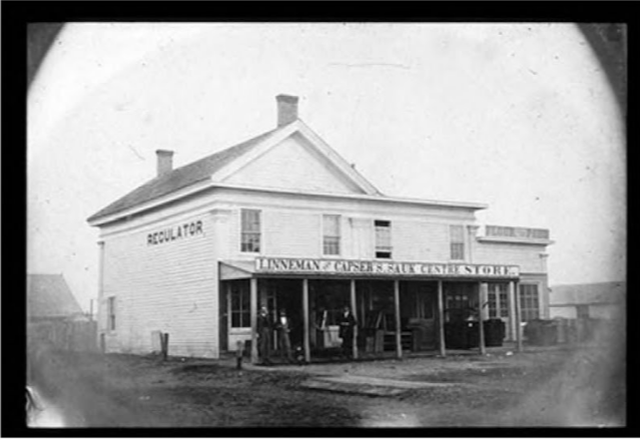"A Peek into the Past"
Enjoy this stroll down memory lane (if you're 150+ years old that is) and learn about some of the first buildings in Sauk Centre.
This is just a glimpse into Sauk Centre's pioneer heritage, with a fraction of the photographs and information we have in our museum.
To learn more about Sauk Centre or to schedule a tour of the History Museum:
This is just a glimpse into Sauk Centre's pioneer heritage, with a fraction of the photographs and information we have in our museum.
To learn more about Sauk Centre or to schedule a tour of the History Museum:
Capser Store, 1864
Capser store was one of the earliest business buildings in Sauk Centre bought by Joseph Capser. Joseph Capser was a European immigrant born in Bavaria in 1833 and farmed in St Joseph, Minnesota before shifting to Sauk Centre where he established Capser store which had a saloon and was a place for farmers and a stop place for travellers with wagons and teamsters. In 1864, during fall season, Joseph Capser expanded the store when he bought the building shown in the picture from Alexander Moore the founder of Sauk Centre. The building stood at the east corner of Main and 3rd street. In this building Capser went into business with his partner J.H Linneman of St Joseph.
|
Sauk Centre HouseWas the 3rd business building in Sauk Centre. The Sauk Centre House was a saloon, a hotel and a brothel before 1900. The building burned down in 1900 and later in 1901 the current Palmer House was built over it's ashes. Local folklore says it is the ghosts of the people who lived during the time of Sauk Centre House that are said to haunt the Palmer House today.
|
1868 Sauk CentreA Wilfred J. Whitefield's 1868 lithograph, which emphasizes the natural setting of Sauk Centre. Animals are seen in the foreground, the river meanders in the middle distance and the buildings are seen at the distance in Greek revival style with streets laid in grid less patterns. The two smokestacks show the town's progressive industrial spirit.
|
1877 Sauk CentreAn 1877 photograph of Sauk Centre which shows a different perspective from Wilfred J. Whitefield's 1868 Lithograph. The town showcases presence of classically inspired L shaped houses in the center and right as well as less attractive buildings scattered throughout the town. It is evident that the town suffered health sanitation problems, fire prevention problems and street maintenance problems which Whitefield had tried to eliminate in his 1868 lithograph.
|
Main Street, 18771877 Main Street scene (Viewing North of 4th Street) shows a raw frontier.
The buildings on the left are false fronts, a representation of the earliest type of architecture in the west and the middle west. These obscure false fronts are thought to have originated from the California mining towns after the 1849 Gold rush. The false front architectural design however provided a more or less consistent street line at the cornice level and made a space for business signs. |











